skip to main |
skip to sidebar
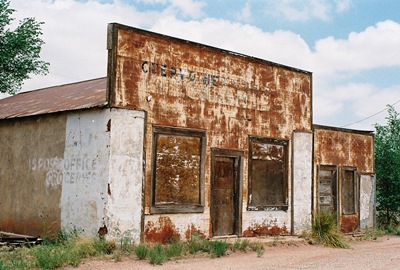
When it comes to ghost towns, it doesn’t get much better than Cuervo, New Mexico. Its condition is remarkable not just because the town is no secret, as any internet search will attest, but because it’s literally feet from Interstate 40. Clearly, most people on the road between Albuquerque and Tucumcari don’t stop for a visit. Either they don’t know about Cuervo or they don’t care. That’s fine with me, although it doesn’t quite keep all the riff-raff out, as I’ll explain later.
Pulling into desolate, (mostly) deserted Cuervo is like driving into the apocalypse, if the apocalypse happened in 1920. Just forget about the semis whizzing by on I-40 and there are only old cars and older houses, scraps of clothes and newspapers from decades ago, everything in that hauntingly arrested state that all aficionados of the lost desire.

It’s always useful to know the names of places, regardless of the language they’re in, and that’s true in Cuervo. The town’s name means “crow,” (or, alternatively, "raven") and while there may have been many of these dark birds around at one point, not a single one was seen on our visit. Perhaps they were hanging out on nearby Cuervo Hill, the town's namesake. Or, maybe, unlike us, they were simply smart enough to stay out of the relentless heat of the midday sun.
Like so many others in New Mexico, Cuervo was a railroad town, brought to life about 1902 when the Chicago, Rock Island, and Pacific Railroad came through and turned the little outpost into a water stop. Before that, the town site had been on a trade route in use since at least the early 1500’s, but no one had previously thought to try to settle down way out on the wide and lonely plains.
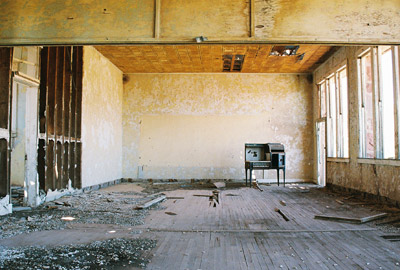
Cuervo started off with a bang as an expansion of cattle and sheep ranching swept through the area in 1910. A couple decades later, Route 66 ran straight through town, easily supporting the few gas stations and hotels that sprang up in its wake. At its height, Cuervo had two of everything a person could want: schools, churches, doctors, and hotels.
One school, built around 1930 and closed in 1958, stands alone in a field of red dirt and was the high point of this visit to Cuervo.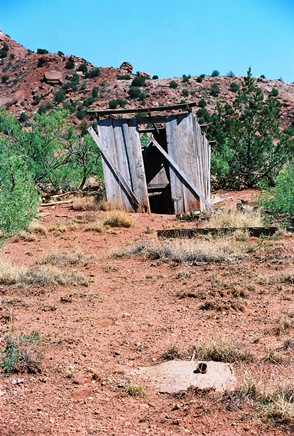 It might have been purchased by an elderly lady last fall for $10,250, though I’m not sure if the sale actually went through. That's the old outhouse to the left and classroom above. Also, both churches are extant. The Catholic church on the south side of I-40 was built of red sandstone during WWI. It’s well-maintained to this day. The Getty Memorial Baptist Church, on the north side, represented the low point of our trip. Again, I’ll explain shortly.
It might have been purchased by an elderly lady last fall for $10,250, though I’m not sure if the sale actually went through. That's the old outhouse to the left and classroom above. Also, both churches are extant. The Catholic church on the south side of I-40 was built of red sandstone during WWI. It’s well-maintained to this day. The Getty Memorial Baptist Church, on the north side, represented the low point of our trip. Again, I’ll explain shortly.
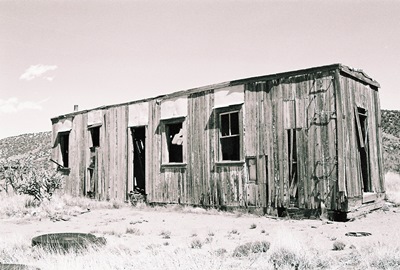
As with dozens of towns that owed their existence to the railroad and Route 66, the construction of the interstate system was a death knell. In the case of Cuervo, in the late 1960’s, I-40 was put right through the center of town, probably turning the lives of many residents into something like a John Mellencamp song.
But it’s worth bearing in mind that Cuervo was never a metropolis. Its population in 1946, immediately post-WWII, was only 128. In 1981, Philip Varney reported in New Mexico’s Best Ghost Towns that many homes remained occupied. Its population now may be in the single digits, including the owner of the non-functioning gas station on the north side of I-40. If you came to take pictures, I hear he won’t be happy to see you. He may well have good reason.
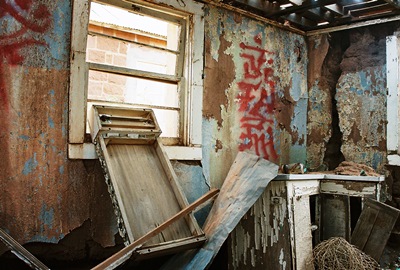
Now, over the years, I’ve occasionally gotten letters from people asking how they can access the places I’ve photographed.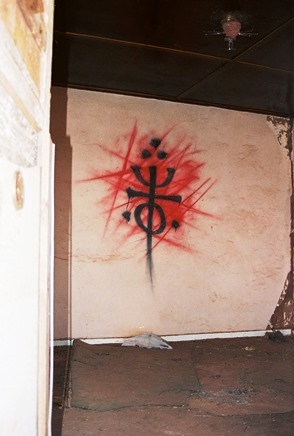 In every case, I’m careful to point out that I don’t want to encourage people to visit these sites, mostly for their own safety. Save it for people with unhealthy compulsions. Like me. Sometimes there is the problem of trespassing. But, in the case of Cuervo, which, as I mentioned, isn’t exactly unknown to explorers, very few buildings are posted as private property. In fact, aside from falling through a floor or having a roof cave in on you, the main danger in abandoned buildings is other people.
In every case, I’m careful to point out that I don’t want to encourage people to visit these sites, mostly for their own safety. Save it for people with unhealthy compulsions. Like me. Sometimes there is the problem of trespassing. But, in the case of Cuervo, which, as I mentioned, isn’t exactly unknown to explorers, very few buildings are posted as private property. In fact, aside from falling through a floor or having a roof cave in on you, the main danger in abandoned buildings is other people.

On that note, as of a few weeks ago, I can report that the Getty Memorial Baptist Church (pictured above) contains the most alarming installation I’ve seen since someone hung a rabbit at the Clearwater Textile Mill in 2004. So, if you ever find yourself wanting to check out the old Baptist church, drop me a line and I’ll tell you EXACTLY why you shouldn’t. Sorry, can’t post a photo of this one…or even describe it. Let's just say that there's evidence of return visits and an encounter could well go badly.
Alright, enough of that. I didn't know that Philip Varney recently released a new ghost town book! It was even in the Huffington Post. Of course, his NM ghost town guide was my primary source here. I also got a few tidbits from Ghost Towns Alive by Linda G. Harris. A little more background was plucked from Legends of America. The factoid about the woman who bought the old school came from a website called Topix but it's gone now.
Next time I think we’ll head down old Route 66 a couple miles to Newkirk and Montoya.
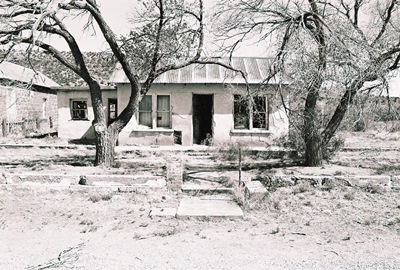
NOVEMBER 2014 UPDATE: Since I published this post 16 months ago I've probably answered a couple hundred inquiries about just what was in the Getty Memorial Baptist Church. I even developed a form letter response that I would revise as information came in. But now I can refer people to KRQE News 13 where THIS PIECE illustrates the scenes at two different locations in the area better than I could describe them here. Although things seem much calmer in Cuervo and there is some consistent activity (the school has been restored and has a nice, new roof!), I'm still not going to encourage people to visit because...there is no real end to the story. Also, to answer another common question, yes, the symbol on the wall in this post has been confirmed as Satanic. But that's almost certainly unrelated to what was in the Getty and elsewhere.
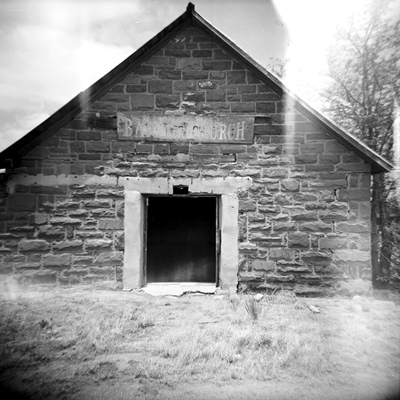

These days Vaughn, New Mexico is probably best known for its police force, which consists of a single drug-sniffing dog named Nikka. Last year there was a police chief, but he owes tens of thousands of dollars in child support and was accused of selling one of the town's rifles and keeping the proceeds. A second officer recently pleaded guilty to assault and battery, but he was never officially certified anyway. That leaves Nikka and the Guadalupe County Sheriff’s Department to keep the peace in Vaughn which, despite it being considered a stopover for drug smugglers, probably isn’t that difficult. But Vaughn, with a population of 438 (down from 539 in 2000), wasn’t always as quiet as it is today.
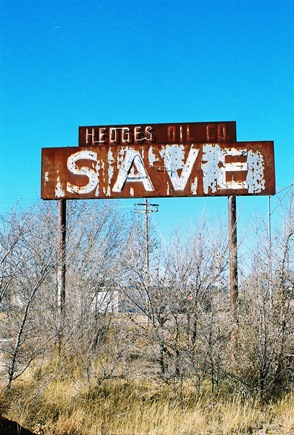 In fact, Vaughn used to rattle and clack quite a bit. That's because by 1905 it was where the Atchison, Topeka & Santa Fe (ATSF) and El Paso & Southern Railroads intersected, the only place in New Mexico where two major railways crossed. It was also a division point for the railroad, with a roundhouse, multiple tracks, and a railroad office. After the arrival of the automobile, it became the town where three US Highways--54, 60, and 285--met.
In fact, Vaughn used to rattle and clack quite a bit. That's because by 1905 it was where the Atchison, Topeka & Santa Fe (ATSF) and El Paso & Southern Railroads intersected, the only place in New Mexico where two major railways crossed. It was also a division point for the railroad, with a roundhouse, multiple tracks, and a railroad office. After the arrival of the automobile, it became the town where three US Highways--54, 60, and 285--met.
But before Vaughn even had a name it was a favored resting place during drives on the Stinson Cattle Trail. Jim Stinson worked for the New Mexico Land and Livestock Company and, beginning in 1882, would bring up to 20,000 head of cattle at a time from Texas to homesteads and forts in the Estancia Valley of east-central New Mexico.
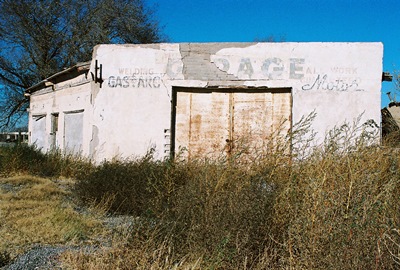
Vaughn got its name from Major G.W. Vaughn, who was a civil engineer for the ATSF. Right off the bat there was a water shortage and, in 1908, the ATSF built a water tank and two underground cisterns to try to collect as much of the precious liquid as they could. Drinking water was brought in by tanker from nearby Willard and Negra. The El Paso & Southern did a little better, having their water transported via wooden pipe from Bonito Lake, 100 miles to the southwest. In 1909, the ATSF figured it would just be easier to pay the El Paso & Southern 24 cents per thousand gallons than try to collect their own water any longer.
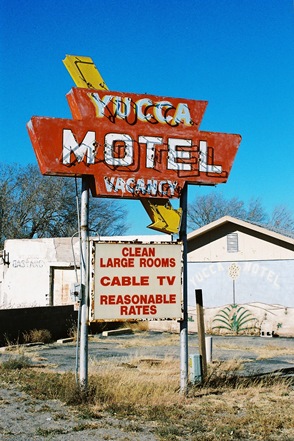 In 1910, the Los Chavez Harvey House opened, named after the Chavez family, who arrived in the area with Don Juan de Onate and the first European settlers in the late 1500’s. The Harvey House in Vaughn served as kind of a minor league team for newly recruited Harvey Girls who were just learning the proper way to look nice and be good. The hotel itself never saw many guests and closed in 1936.
In 1910, the Los Chavez Harvey House opened, named after the Chavez family, who arrived in the area with Don Juan de Onate and the first European settlers in the late 1500’s. The Harvey House in Vaughn served as kind of a minor league team for newly recruited Harvey Girls who were just learning the proper way to look nice and be good. The hotel itself never saw many guests and closed in 1936.
Charles Lindbergh even stopped in Vaughn, but not because he particularly wanted to. In 1928, engine failure forced him to land his plane and wait in town a few days for a replacement part to arrive. He stayed at the Harvey House and, apparently, despite the best efforts of the girls, was not interested in socializing with them in the slightest. To read about another stranded traveler who felt an initial distaste for Vaughn, yet eventually came around, I used to recommend a stop at Viva New Mexico, but it's gone now. However, you can still read the piece if you head over to New Mexico Magazine.
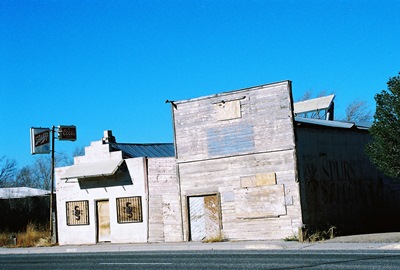
Vaughn wasn’t incorporated until 1919, but by 1920 it had a relatively healthy population of about 1000. However, the number of residents may never have climbed much higher than that. One Harvey Girl, Alice Garnas, said in 1926, “Vaughn was a shocking place. There was no place to go, nothing to do. Just Vaughn and those wide plains on all sides--cattle country. But it was for me.”
 And it might be for you, too. But if, like many, you’re just passing through, try to make a stop at Penny’s Diner. Look for the restaurant at the crossroads that appears to be inside a large aluminum Airstream trailer. Once you enter, it’ll be 1955 all over again and you’ll swear you can hear that clickity-clack as the iron horses rumble through.
And it might be for you, too. But if, like many, you’re just passing through, try to make a stop at Penny’s Diner. Look for the restaurant at the crossroads that appears to be inside a large aluminum Airstream trailer. Once you enter, it’ll be 1955 all over again and you’ll swear you can hear that clickity-clack as the iron horses rumble through.
Like the previous post, on the town of Encino, most of the hard-to-find information and quotes included here came from Dixie Boyle’s excellent book, “A History of Highway 60 and the Railroad Towns of the Belen, New Mexico Cutoff.” Ms. Garnas' quote came from "The Harvey Girls: Women Who Opened the West," by Lesley Poling-Kempes. I also grabbed a bit from Wikipedia, the aforementioned Viva New Mexico, and the LA Times, believe it or not.
Next time we’re going to one of the best ghost towns I know, Cuervo, NM.
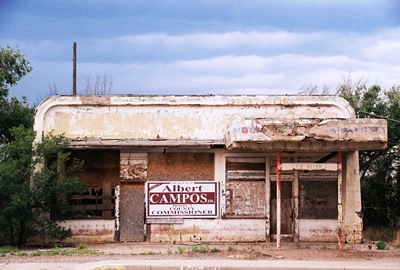
NOVEMBER 2014 UPDATE: A reader recently sent in some postcards and stories about the Sands Motel, which their grandfather built and owned. This history was so extensive that I wanted to present it here. Happily, I was given the go-ahead. So, here's the story of the Sands Motel:
"My name is Dana McElyea and I live in Texas. These pictures are of the Sands Motel in Vaughn that my grandfather Jack Cormany built in the early 1960's. The motel was just as you came into town from the west. We spent every Christmas and summer traveling there when we were young.
"My grandfather was an incredible man that could do anything. He had several inventions and had Dr. Pepper bottling companies at one time before the motel. He moved to Vaughn for the climate and built the motel there due to the intersection of highways. I still have linens and dishes from the motel and the cafe.
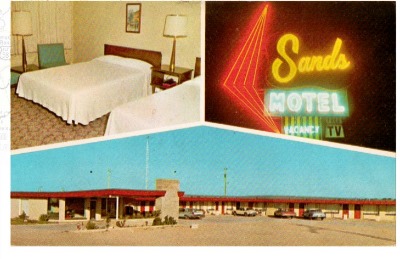
"He sold the motel and moved to a 17-room house there in Vaughn that used to be a clinic from what I understand. That was farther down the street, right next to a church that was on the corner. It was a really nice house. They had named each of the 17 rooms, some according to what they had been when it was a clinic; baby room, waiting room, blue room, book room. The house had a beautiful rock fireplace that covered a wall. It really was beautiful inside for Vaughn. ;)
"Me and my two older brothers used to play in the glass enclosed check-in office at night. We would turn out all the lights and when a car drove past on the highway we would see who could 'hit the deck' the fastest before it saw us. Ha! If you look close on the far right side of the motel there’s a cement pad. That is where my brother shot me in my little toe with a BB gun because I wouldn't 'dance' like he told me to. Haha! Many good childhood memories in Vaughn. ;)
"I especially remember how wonderful my grandparents were to anyone staying in the motel. It was more like a bed and breakfast. Sometimes people stayed for days if they were snowed in. I have pictures of the snow up to the roof line and my grandfather having to use his tractor to clear it away.
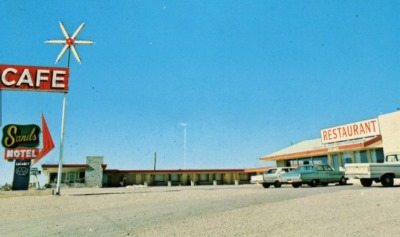
"My grandfather passed away in the late 1970s. My grandmother continued to live in Vaughn until we moved her to Texas around 2000. She has passed as well.
"I read in the comments where someone inquired about the Cassidy family. My grandparents were very good friends with the Cassidy's and I believe they even traveled together some in my grandfather’s trailer.
"I just thought you might like some history on the motel. It was always so nice when my grandfather had it. I have many fond memories of Vaughn. It's heartbreaking to see the condition of it now."
Many thanks to Dana McElyea for sharing her postcards and memories.



 It might have been purchased by an elderly lady last fall for $10,250, though I’m not sure if the sale actually went through. That's the old outhouse to the left and classroom above. Also, both churches are extant. The Catholic church on the south side of I-40 was built of red sandstone during WWI. It’s well-maintained to this day. The Getty Memorial Baptist Church, on the north side, represented the low point of our trip. Again, I’ll explain shortly.
It might have been purchased by an elderly lady last fall for $10,250, though I’m not sure if the sale actually went through. That's the old outhouse to the left and classroom above. Also, both churches are extant. The Catholic church on the south side of I-40 was built of red sandstone during WWI. It’s well-maintained to this day. The Getty Memorial Baptist Church, on the north side, represented the low point of our trip. Again, I’ll explain shortly.

 In every case, I’m careful to point out that I don’t want to encourage people to visit these sites, mostly for their own safety. Save it for people with unhealthy compulsions. Like me. Sometimes there is the problem of trespassing. But, in the case of Cuervo, which, as I mentioned, isn’t exactly unknown to explorers, very few buildings are posted as private property. In fact, aside from falling through a floor or having a roof cave in on you, the main danger in abandoned buildings is other people.
In every case, I’m careful to point out that I don’t want to encourage people to visit these sites, mostly for their own safety. Save it for people with unhealthy compulsions. Like me. Sometimes there is the problem of trespassing. But, in the case of Cuervo, which, as I mentioned, isn’t exactly unknown to explorers, very few buildings are posted as private property. In fact, aside from falling through a floor or having a roof cave in on you, the main danger in abandoned buildings is other people.



 In fact, Vaughn used to rattle and clack quite a bit. That's because by 1905 it was where the Atchison, Topeka & Santa Fe (ATSF) and El Paso & Southern Railroads intersected, the only place in New Mexico where two major railways crossed. It was also a division point for the railroad, with a roundhouse, multiple tracks, and a railroad office. After the arrival of the automobile, it became the town where three US Highways--54, 60, and 285--met.
In fact, Vaughn used to rattle and clack quite a bit. That's because by 1905 it was where the Atchison, Topeka & Santa Fe (ATSF) and El Paso & Southern Railroads intersected, the only place in New Mexico where two major railways crossed. It was also a division point for the railroad, with a roundhouse, multiple tracks, and a railroad office. After the arrival of the automobile, it became the town where three US Highways--54, 60, and 285--met.
 In 1910, the Los Chavez Harvey House opened, named after the Chavez family, who arrived in the area with Don Juan de Onate and the first European settlers in the late 1500’s. The Harvey House in Vaughn served as kind of a minor league team for newly recruited Harvey Girls who were just learning the proper way to look nice and be good. The hotel itself never saw many guests and closed in 1936.
In 1910, the Los Chavez Harvey House opened, named after the Chavez family, who arrived in the area with Don Juan de Onate and the first European settlers in the late 1500’s. The Harvey House in Vaughn served as kind of a minor league team for newly recruited Harvey Girls who were just learning the proper way to look nice and be good. The hotel itself never saw many guests and closed in 1936.
 And it might be for you, too. But if, like many, you’re just passing through, try to make a stop at
And it might be for you, too. But if, like many, you’re just passing through, try to make a stop at 

